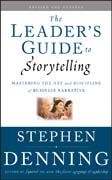
The leader's guide to storytelling: mastering the art and discipline of business narrative, revised and updated
Denning, Stephen
INDICE: Preface. Introduction The purpose of the book and the process by which it came to be written. Part One: The Role of Story in Organizations. 1 Telling the Right Story: Choosing the Right Story for the Leadership Challenge atHand. Based on the author's personal journey of discovery, the chapter offersa catalogue of narrative patterns and a cost-benefit analysis of organizational storytelling. 2 Telling the Story Right: Four Key Elements of Storytelling Performance. In an organizational context, telling the story right usually begins by choosing a plain style in which you tell the story as though you are talking to a single individual. You tell the truth as you see it, and prepare carefully for the performance. In the actual performance, you make yourself fully available for the audience and endeavor to connect with them as individuals.Part Two: Eight Narrative Patterns. 3 Motivate Others to Action: Using Narrative to Ignite Action and Implement New Ideas. The challenge of igniting actionand implementing new ideas is pervasive in organizations today. The main elements of the kind of story that can accomplish thisa springboard storyare the story's foundation in a sound change idea, its truth, its minimalist style, andits positive tone. 4 Build Trust: Using Narrative to Communicate Who You Are.Communicating who you are and so building trust in you as an authentic personis vital for today's leader. The type of story that can accomplish this typically focuses on a turning point in your life. It has a positive tone and is told with context. Sometimes it is appropriate to tell your story, but sometimesit isn't. 5 Use Narrative to Build Your Brand: The World of Social Media. Just as a story can communicate who you are, a story can communicate who your company is. Stories that the company tells about its brand are becoming less important than stories that customers tell. The products and services that are being offered are often the most effective vehicle to communicate the brand narrative to external stakeholders. 6 Transmit Your Values: Using Narrative to Instill Organizational Values. Values differ: there are robber baron, hardball, instrumental, and ethical values; there are personal and corporate values, and espoused and operational values. Values are established by actions and can be transmitted by narratives like parables that are not necessarily true and are typically told in a minimalist fashion. 7 Get Others Working Together: Using Narrative to Get Things Done Collaboratively. Different patterns of working together include work groups, teams, communities, and networks. Whereas conventional management techniques have difficulty in generating high-performing teams and communities, narrative techniques are well suited to the challenge. 8 ShareKnowledge: Using Narrative to Transmit Knowledge and Understanding. Knowledge-sharing stories tend to be about problems and have a different pattern from the tradi
- ISBN: 978-0-470-54867-7
- Editorial: John Wiley & Sons
- Encuadernacion: Cartoné
- Páginas: 368
- Fecha Publicación: 17/02/2011
- Nº Volúmenes: 1
- Idioma: Inglés
